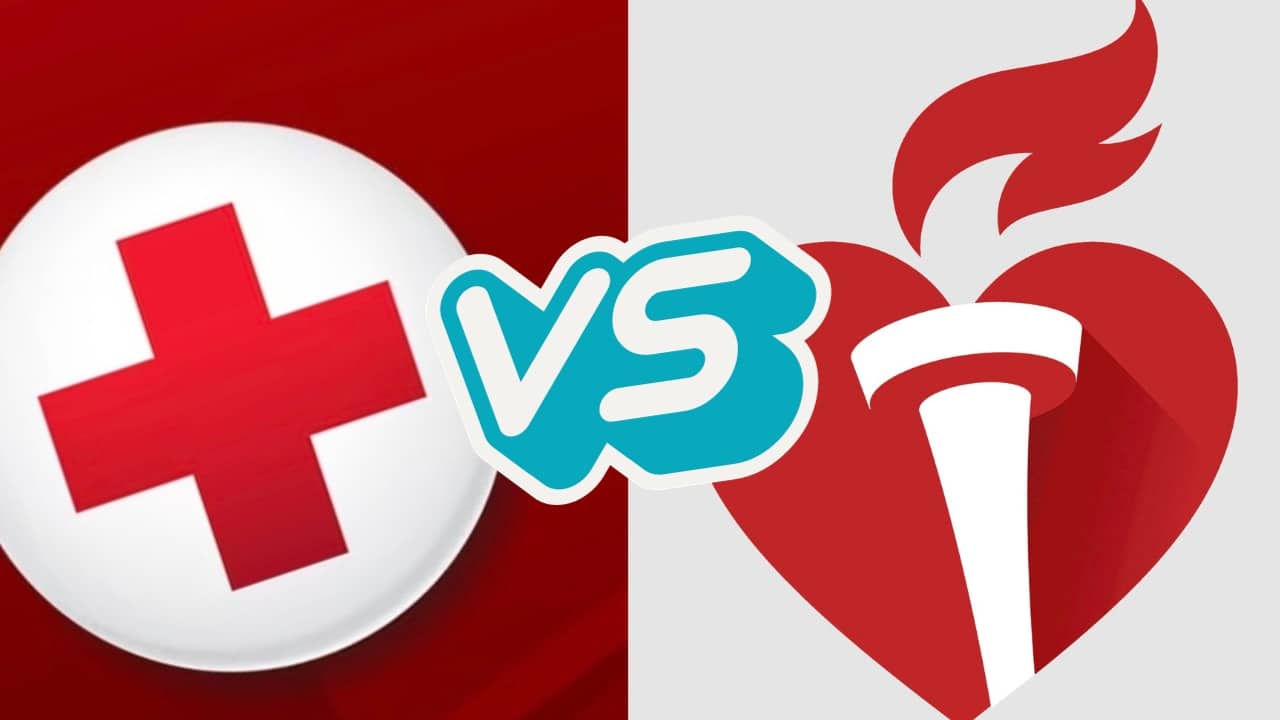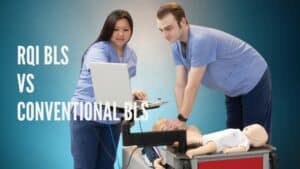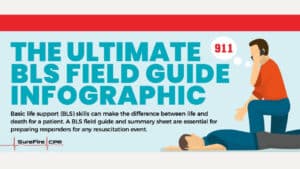As a healthcare provider, getting Basic Life Support (BLS) certification is essential. BLS courses will give you invaluable knowledge from CPR to choking treatment.
If you’ve looked into BLS certifications, you may have noticed there are two main programs: American Heart Association (AHA) Basic Life Support and American Red Cross (ARC) Basic Life Support. In this post, we’ll explain the differences between the two agencies’ programs so that you can choose the right one for your goals.
Who Comes Up with the BLS Guidelines?
BLS is the foundation of healthcare provider resuscitation and all BLS courses are based on the guidelines from ILCOR which is the International Liaison Committee on Resuscitation. ILCOR publishes the guidelines and then the American Heart Association, Red Cross, and all other training providers base their courses off of that material.
Overview of American Heart Association BLS
The Red Cross Basic Life Support course covers essential BLS topics including rapid patient assessment, opioid overdoses, and CPR for adults, children, and infants. Their course is designed for healthcare professionals who might respond to cardiac emergencies.
Red Cross BLS vs American Heart Association BLS: Curriculum Comparison
Both certifications are widely known and reputable. Either way, you’ll gain a solid foundation of BLS knowledge and skills. However, there are some key differences between American Red Cross vs American Heart Association BLS.
Consider the following differences when making your selection.
1. Training Methodologies
As far as the class method itself, the American Heart Association has 2 core training options available. Students can pick between blended learning, online sessions with an in-person skills check, or traditional classroom training. The American Red Cross also offers both hybrid and traditional sessions.
Trying to decide which class to take? For experienced providers working in the emergency setting, we recommend hybrid online BLS training. For new providers, or those that are not providing CPR on a regular basis, we recommend the traditional, instructor-led class. That way you’ll get more practice time and be able to ask all of the questions you want.
2. Course Duration and Accessibility
Course duration clearly differs between American Heart Association and Red Cross BLS. The American Red Cross Basic Life Support course runs approximately 4.5 hours, while AHA BLS is approximately 3.5 hours. This might not be a deal-breaker for some, but for others, the extra time commitment can be a deterrent. If you’re a busy medical professional, additional hours can add up.
Both courses offer digital certification cards for your convenience. The Red Cross and American Heart Association both have an online portal for students to view, share, and print their cards at any time. No matter which type of course you take, your training provider should be able to provide a new card or help students gain access to the portals if needed.
3. Industry Acceptance and Recognition
Both are widely accepted across the industry. If you need a BLS certificate for work, check with your employer to see whether they require a specific program.
The American Red Cross is a well-known emergency response organization established in 1881. The American Heart Association is also a recognizable national organization. It was founded in 1924 and has since grown into the U.S.’s largest voluntary organization focused on heart disease and stroke.
4. Recertification and Renewal Process
Another aspect to consider is renewal frequency. If your job requires BLS training, you’ll need to take renewal classes to maintain your certification.
The American Red Cross offers an abbreviated BLS course. This shorter BLS renewal class is an overview of the course and does not go into as much detail as the initial certification session. It can be taken if a BLS certificate is about to expire or is within 30 days of expiration. After 30 days, students need to take the full course to maintain certification. There is no dedicated American Heart Association renewal course, but students can simply sign up for another BLS certification course with their training provider.
5. Cost Comparison
While the exact cost of a BLS certification class varies by provider, courses generally cost between $50 and $125. However, when selecting a BLS course, you should consider expenses beyond the initial course cost. Is one training program offered at a nearby center, meaning you can save on gas or transportation? Does one program have convenient times so that you won’t have to miss work?
Conclusion - Which Certification Is Better?
Both programs are an effective, reputable way to learn Basic Life Support techniques and get certified. Ultimately, the best program is the one that your employer (or future employer) will accept. In Southern California, the majority of hospitals only accept AHA BLS Certifications, so that is what we offer at SureFire CPR. If you’re in doubt between AHA vs. ARC BLS, a great first step is to ask the HR department at your work. And if you’re just starting out, your local CPR certification company should know the answer too.
Take a training course with SureFire CPR and earn your AHA BLS certification today. We have multiple centers throughout Southern California and a wide selection of courses to make learning BLS convenient for everyone.
FAQs
What is the difference between American Red Cross BLS and American Heart Association BLS?
There are a few differences between American Red Cross BLS and American Heart Association BLS including training methodologies and course duration.
Should I take AHA BLS or ARC BLS?
If you need to be BLS certified for work, you should check with your employer to see if they prefer one over the other. If not, the choice is up to you. Consider your own preferences and goals.
Why should I take American Heart Association BLS?
The American Heart Association is a research organization that has developed in-depth, well-recognized Basic Life Support course curriculums.
Which BLS course is easier?
It depends on your personal learning style. However, the American Heart Association BLS exam requires a score of 84% to pass, while you can pass the ARC BLS exam with an 80% or higher.
Is BLS and AHA the same thing?
AHA, the American Heart Association, offers a BLS course. They develop the materials to help healthcare providers learn Basic Life Support skills.











